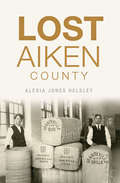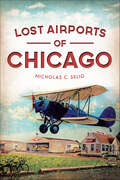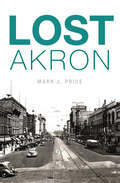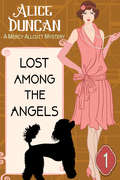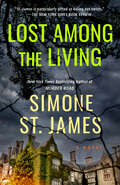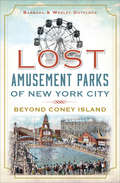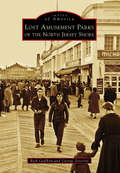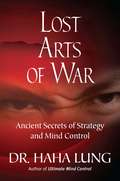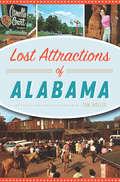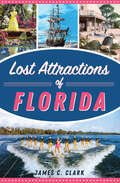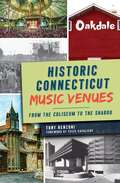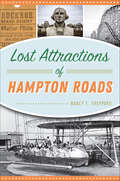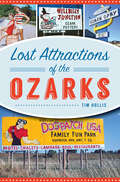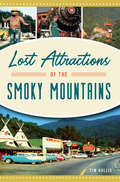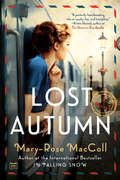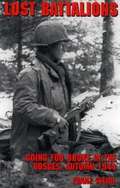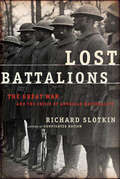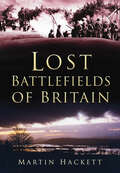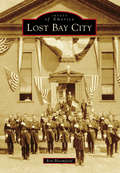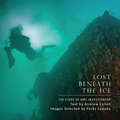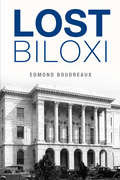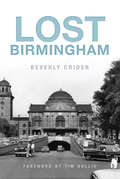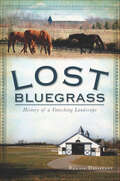- Table View
- List View
Lost Aiken County (Lost)
by Alexia Jones HelsleyFrom a home to the fierce Westo tribe to a hub of the equestrian industry, Aiken County has had a huge influence on South Carolina. And some of the structures that mark that history have disappeared. More than two hundred years ago, the Horse Creek Chickasaw Squirrel King held court near North Augusta. The first locomotive built for public transportation, the "Best Friend" from Charleston to Hamburg, first ran in the area. The home of noted businessman Richard Flint Howe hosted both the Duke and Duchess of Windsor and students of the University of South Carolina Aiken. William Gregg and the Graniteville Mill helped shape the textile industry in the state. Author Alexia Jones Helsley details the lost history of Aiken County.
Lost Airmen: The Epic Rescue of WWII U.S. Bomber Crews Stranded Behind Enemy Lines
by Charles E. Stanley Jr.Late in 1944, thirteen U.S. B-24 bomber crews bailed from their cabins over the Yugoslavian wilderness. Bloodied and disoriented after a harrowing strike against the Third Reich, the pilots took refugee with the Partisan underground. But the Americans were far from safety. Holed up in a village barely able to feed its citizens, encircled by Nazis, and left abandoned after a team of British secret agents failed to secure their escape, the airmen were left with little choice. It was either flee or be killed. In The Lost Airmen, Charles Stanely Jr. unveils the shocking true story of his father, Charles Stanely-and the eighteen brave soldiers he journeyed with for the first time. Drawing on over twenty years of research, dozens of interviews, and previously unpublished letters, diaries, and memoirs written by the airmen, Stanley recounts the deadly journey across the blizzard-swept Dinaric Alps during the worst winter of the Twentieth Century-and the heroic men who fought impossible odds to keep their brothers in arms alive.
Lost Airports of Chicago (Lost)
by Nicholas C. SeligTo book a ride on the "World's Shortest Airline" or learn aerial stunts from the redheaded widow of Lawrence Avenue, you've got to go through the airports buried beneath the housing developments and shopping malls of Chicagoland. Many of these airports sprang up after World War I, when training killed more pilots than combat, and the aviation pioneers who developed Chicago's flying fields played a critical role in getting the nation ready to dare the skies in World War II. Author Nick Selig has rolled wheels on his fair share of Chicago's landing strips but faces an entirely new challenge in touching down in places being swallowed by a city and forgotten by history.
Lost Akron (Lost)
by Mark J. PriceFrom a prehistoric locale like the Big Falls of the Cuyahoga River to the cavernous 1970s majesty of the Coliseum, explore the places that have melted away in Akron's changing landscape. Remember M. O'Neil Company? Akron Times-Press? The North Hill Viaduct? WAKR-TV? Norka Soda? Rolling Acres Mall? These are icons that all defined the city and its people. For those who live in Akron, for those who have moved away and for those too young to remember the Rubber City's heyday, author Mark J. Price takes a fascinating look at fifty vanished landmarks from Akron's past.
Lost Among the Angels: Historical Cozy Mystery (Mercy Allcutt Mystery #1)
by Alice DuncanLocal Secretary Foils Murderer in Lost Among the Angels, a Historical Cozy Mystery from Alice Duncan1920s, Los Angeles, CAMercy Allcutt is ecstatic to move to California where she knows she’ll learn all about life and–to her Boston blue-blood family's horror--get a JOB; no woman in the Allcutt family has ever actually held a JOB.Mercy lands employment as secretary to Ernie Templeton, Private Investigator. Mercy’s thrilled, and she’s sure, with time and help, she’ll become an invaluable asset to Ernie’s business.Ernie doesn't yet share Mercy's sunny optimism, but nothing tests the resolve of a new employee quite like murder.Publisher Note: Readers who enjoy cozy mysteries in historical settings are sure to appreciate the Mercy Allcutt series set in 1920s Los Angeles, California. No vulgarity or explicit sex for those who appreciate a clean and wholesome read."Mercy is a pip. I laughed all through this book and stayed up until 4:00 in the morning to finish it. I was still laughing when I turned out the light. Not a bad way to end one day and start another." ~Patricia Browning"This gem reminded me of the old Dick Tracy comic strips (that I avidly read as a child), as well as of the black and white PI movies we all recall with glee. The story takes place in 1926, Los Angeles. I found myself immersed in the first few pages. Author Alice Duncan either did a lot of research or grew up on stories of the era. Each character has a unique personality. The characters all dress the parts, all the way down to the bobbed hairstyle, and speak slang. Don't worry; you won't be lost. This book is headed directly to my "KEEPER" shelf. Highly recommended!" ~ Detra Fitch (Huntress Reviews)"I read Lost Among the Angels in one sitting and found it wonderful and so enjoyable. It is a fast-paced, exciting story and Mercy Allcutt is a terrific sleuth. I can't wait to spend more time with Mercy!" ~ Rob WalkerThe Mercy Allcutt Mystery SeriesLost Among the AngelsAngels FlightFallen AngelsAngels of MercyThanksgiving Angels
Lost Among the Living
by Simone St. JamesFrom the New York Times bestselling author of Murder Road comes a gripping novel that &“is the perfect blend of history and mystery, with a little paranormal activity and romance thrown in for the ride&” (Suspense Magazine). England, 1921. Three years after her husband, Alex, disappeared, shot down over Germany, Jo Manders still mourns his loss. Working as a paid companion to Alex's wealthy, condescending aunt, Dottie Forsyth, Jo travels to the family&’s estate in the Sussex countryside. But there is much she never knew about her husband&’s origins…and the revelation of a mysterious death in the Forsyths&’ past is just the beginning… All is not well at Wych Elm House. Dottie's husband is distant, and her son was grievously injured in the war. Footsteps follow Jo down empty halls, and items in her bedroom are eerily rearranged. The locals say the family is cursed, and that a ghost in the woods has never rested. And when Jo discovers her husband&’s darkest secrets, she wonders if she ever really knew him. Isolated in a place of deception and grief, she must find the truth or lose herself forever. And then a familiar stranger arrives at Wych Elm House…
Lost Amusement Parks of New York City: Beyond Coney Island (Lost Ser.)
by Wesley Gottlock Barbara GottlockA historical tour of fun and frolic in the five boroughs—including photos from the good old days. Coney Island is an iconic symbol of turn-of-the-century New York—but many other amusement parks have thrilled the residents of the five boroughs. Strategically placed at the end of trolley lines, railways, public beaches, and waterways, these playgrounds for the rich and poor alike first appeared in 1767. From humble beginnings, they developed into huge sites like Fort George, Manhattan&’s massive amusement complex. Each park was influenced by the culture and eclectic tastes of its owners and patrons—from the wooden coasters at Staten Island&’s Midland Beach to beer gardens on Queens&’ North Beach and fireworks blasting from the Bronx&’s Starlight Park. As real estate became more valuable, these parks disappeared. With this historical tour, you can rediscover the thrills of the past from the lost amusement parks of New York City.
Lost Amusement Parks of the North Jersey Shore (Images of America)
by George Severini Rick GeffkenThe Jersey Shore has always attracted people seeking relief from summer heat and humidity. Long before Europeans came here, the native Lenape clammed, fished, and played games on the beach and in the surf. These original people could scarcely have imagined that, by the end of the 19th century, the 120-mile-long coastline of New Jersey would be dotted with amusement parks featuring gentle kiddie car rides, terrifying roller coasters, merry-go-rounds, and fast-food emporiums. James Bradley in Asbury Park and William Sandlass Jr. in Highland Beach created mass entertainment for hundreds of thousands of people. Their seaside recreation centers, along with those in Long Branch, Bradley Beach, Pleasure Bay, and others, endured for years but are just fond and fading memories today.
Lost Ann Arbor
by Susan Cee WinebergAnn Arbor might have become just another small Michigan village had it not been for one crucial event: its designation as the home of the University of Michigan in 1837. Its subsequent development into a thriving cultural and intellectual community was marked by its extraordinary architecture, from the grand 1878 courthouse to the exquisite original university buildings and fashionable East Huron Street. The expansion of the town and university, the arrival of the automobile, and frequent fires began atransformation of Ann Arbor that led to the tragic demolition of some of its most remarkable structures. Lost Ann Arbor is a tribute to these long-lost treasures and the 19th century way of life that accompanied them.
Lost Art of War: Ancient Secrets of Strategy and Mind Control
by Lung Dr HahaSun Tzu's The Art of War is an acknowledged masterpiece--for the general reader. Yet the deeper truths of strategy and mind manipulation have been, until now, known only to true scholars dedicated to deciphering illegible scrolls and mastering the nuances of lost languages. Now, Dr. Haha Lung has at last gathered and fully translated these teachings from the shadows of history--the truly dangerous wisdom of the lesser-known masters--and presents them here for those daring, perhaps unwisely, to attain a higher level of dominance. You'll discover: The 12 Cuts: Voritomo's Art of War The War Scroll of Spartacus Musashi's 6 Ways to be VictoriousThe 99 Truths: Hannibal's Black Art of War And much moreBE ADVISED: For academic study ONLY; publisher assumes NO responsibility for content use/misuse. Dr. Haha Lung is the author of more than a dozen books on martial arts, including Ultimate Mind Control, Mind Penetration, Mind Fist, The Nine Halls of Death, Assassin!, Mind Manipulation, Knights of Darkness, and Mind Control: The Ancient Art of Psychological Warfare.
Lost Attractions of Alabama
by Tim HollisAlabama has had an enviable success rate when it comes to tourist attractions, with some that date back to the 1930s still drawing crowds today. But many others have come and gone, sometimes leaving little evidence of their existence. Join Alabama native Tim Hollis as he revisits iconic attractions such as Canyon Land Park and Sequoyah Caverns, the floral clock at Birmingham's Botanical Gardens and the traffic safety torch held aloft by Vulcan, the iron man. Many Gulf Coast attractions are gone, including Styx River Water World and Spooky Golf, but the memories remain.
Lost Attractions of Florida
by James C. ClarkEverybody knows about Disney World, Universal, EPCOT, Sea World and a slew of other Florida attractions. But how about bygone Sunshine State attractions such as Texas Jim's Sarasota Reptile Farm and Zoo, the Skull Kingdom, the House of Mystery or Dixieland Amusement Park. Many were roadside stops started by families as an extension of a fruit stand or market. Oranges and sodas in the front, alligators in the back. Many of the attractions were free, designed to lure customers for the fruit stand or store. Others changed a small fee. Some became nationally known, such as Cypress Gardens, where Johnny Carson not only broadcast, but water-skied. The roadside attractions had their heyday from the 1920s to the coming of Disney in 1971. It was a much simpler time, and a large tree known as The Senator could become a top attraction, along with a St. Petersburg drug store. Revisit these lost attractions with author Jim Clark.
Lost Attractions of Florida's Miracle Strip (Lost)
by Tim HollisBeginning in the early 1950s, the 130 miles of Florida coastline stretching from Panama City to Pensacola were branded as the Miracle Strip. Between those cities, oddities sprang up: goofy miniature golf courses, neon-bedecked motels, reptile farms and attractions that sought to re-create environments ranging from the South Pacific to the ghost towns of the Old West. In total, it was a marketing effort that worked brilliantly. Tourists flocked to the Strip, and now they can return. Author Tim Hollis presents a colorful array of these now-vanished sights, from the garish Miracle Strip Amusement Park to such oddities as Castle Dracula and the Museum of the Sea and Indian.
Lost Attractions of Hampton Roads (Lost)
by Nancy E. SheppardTake a trip down memory lane to beloved destinations for fun and families across Virginia's tidewater.Cruise the rails of Ocean View Amusement Park's "The Rocket" roller coaster, dig for fossils at Hampton's Rice's Fossil Pit, celebrate the winter season at Portsmouth's Coleman's Nursery and learn the significant role that Buckroe Beach's Bay Shore Beach Park played in American history. From the Great White Fleet to a Wild West park, journey through this vibrant history with author and historian Nancy E. Sheppard and discover whether such cherished places can ever truly be lost.
Lost Attractions of the Ozarks (Lost)
by Timothy (Tim) HollisDiscover the Famous Attractions of Days Gone By When you think about vacationing in the Ozark Mountains, Li'l Abner comic strip characters at Dogpatch USA or scores of their generic cousins elsewhere probably come to mind. But that would be only the beginning. The Ozarks region has scores of attractions to offer tourists and locals alike. From the early music theaters of Branson to the kitschy tourist traps of Lake of the Ozarks, it is a unique part of the nation. Author Tim Hollis details the businesses that no longer exist, from abandoned roadside relics along Route 66 to the concrete prehistoric monsters of Arkansas' Dinosaur World.
Lost Attractions of the Smoky Mountains (Lost)
by Tim HollisThe Great Smoky Mountains National Park is among the most visited national parks in the country, and countless attractions around its borders have tried for decades to siphon some of those valuable tourist dollars. From ersatz western towns and concrete dinosaurs to misplaced Florida-type attractions and celebrity theaters, you will find them all preserved in this book. Author Tim Hollis showcases those businesses that no longer exist, from Hill-Billy Village in Pigeon Forge and Gatlinburg's theme parks on the Tennessee side to the motels of Cherokee and Ghost Town in the Sky on the North Carolina side.
Lost Autumn
by Mary-Rose MacCollAn emotional novel of love and power, about a young woman's coming-of-age in 1920, the royal tour of Edward, Prince of Wales, and the secrets that surface more than seventy years later."A perfectly heartbreaking tale of royalty, lies, and friendship."--Kristin Harmel, author of The Room on Rue AmélieAustralia, 1920. Seventeen-year-old Maddie Bright embarks on the voyage of a lifetime when she's chosen to serve on the cross-continent tour of His Royal Highness, the dashing Edward, Prince of Wales. Life on the royal train is luxurious beyond her dreams, and the glamorous, good-hearted friends she makes--with their romantic histories and rivalries--crack open her world. But glamour often hides all manner of sins. Decades later, Maddie lives in a ramshackle house in Brisbane, whiling away the days with television news and her devoted, if drunken, next-door neighbor. When a London journalist struggling with her own romantic entanglements begins asking Maddie questions about her relationship to the famous and reclusive author M. A. Bright, she's taken back to the glamorous days of the royal tour--and to the secrets she has kept for all these years.
Lost Battalions: Going for Broke in the Vosges, Autumn 1944
by Franz SteidlThe story of two World War II battalions--one German, one American--each cut off behind enemy lines in the same forest at the same time, and the heroic efforts to save them.
Lost Battalions: The Great War and the Crisis of American Nationality
by Richard Slotkin"A work of stunning density and penetrating analysis . . . Lost Battalions deploys a narrative symmetry of gratifying complexity."—David Levering Lewis, The NationDuring the bloodiest days of World War I, no soldiers served more valiantly than the African American troops of the 369th Infantry—the fabled Harlem Hellfighters—and the legendary 77th "lost battalion" composed of New York City immigrants. Though these men had lived up to their side of the bargain as loyal American soldiers, the country to which they returned solidified laws and patterns of social behavior that had stigmatized them as second-class citizens.Richard Slotkin takes the pulse of a nation struggling with social inequality during a decisive historical moment, juxtaposing social commentary with battle scenes that display the bravery and solidarity of these men. Enduring grueling maneuvers, and the loss of so many of their brethren, the soldiers in the lost battalions were forever bound by their wartime experience. Both a riveting combat narrative and a brilliant social history, Lost Battalions delivers a richly detailed account of the fierce fight for equality in the shadow of a foreign war.
Lost Battlefields of Britain
by Martin HackettThe British Isles have witnessed hundreds of battles, both great and small, in their two thousand years of recorded history, but not all are widely remembered today. Many of these battles are well known, due to their far-reaching consequences, their sheer scale or the involvement of famous protagonists. Even so, many battles have never been properly investigated, perhaps because their importance was never understood or because they have never been included in previous books on British battlefields.In this book, Martin Hackett examines ten forgotten British battles, covering the length and breadth of Britain and some 900 years of warfare. For each, he provides a concise account of the battle itself and analyses its military, archaeological and political significance. Each entry is accompanied by current photographs of the location, a modern map of the battlefield with suggested tours and information on exploring the site today.
Lost Bay City
by Ron BloomfieldWhen the phrase "Do you remember?" is uttered in Bay City, it is usually followed by the name of a hotel, restaurant, business, or building. Slowly, many parts of local history have been lost to the sands of time. Fire took many, followed by condemnations and the inevitable advance of progress. An empty lot may be all that remains of a once-prominent structure, but sometimes a new landmark emerges. In the case of one famous address at Center and Water Streets, the Wenonah Hotel rose out of the ashes of the Fraser House, another prominent facade. Seven decades later, the Wenonah, too, succumbed to fire; out of those ashes rose the Delta College Planetarium, a third-generation landmark. Photographs help residents remember, though each person who experienced something firsthand has his or her own distinct connection with these pieces of lost Bay City.
Lost Beneath the Ice: The Story of HMS Investigator
by Andrew CohenThe story of the bold voyage of HMS Investigator and the modern-day discovery of its wreck by Parks Canada’s underwater archaeologists. When Sir John Franklin disappeared in the Arctic in the 1840s, the British Admiralty launched the largest rescue mission in its history. Among the search vessels was HMS Investigator, which left England in 1850 under the command of Captain Robert McClure. While the ambitious McClure never found Franklin, he and his crew did discover the fabled Northwest Passage. Like Franklin’s ships, though, Investigator disappeared in the most remote, bleak and unknown place on Earth. For three winters, its 66 souls were trapped in the unforgiving ice of Mercy Bay. They suffered cold, darkness, starvation, scurvy, boredom, depression and madness. When they were rescued in 1853, Investigator was abandoned. For more than a century and a half, the ship’s fate remained a mystery. Had it been crushed by the ice or swept out to sea? In 2010, Parks Canada sent a team of archaeologists to Mercy Bay to find out. It was a formidable challenge, demanding expertise and patience. There, off the shores of Aulavik National Park, they found Investigator. Lost Beneath the Ice is a tale of endurance, daring, deceit, courage, and irony. It is a story about a tempestuous crew, their mercurial captain, cynical surgeon and kind-hearted missionary. In the end, McClure found fame but lost his ship, some of his crew and much of his honour. Written with elegance and authority, illustrated with archival imagery and startling underwater photographs of Investigator and its artifacts, this is a sensational story of discovery and intrigue in Canada’s Arctic. Andrew Cohen is a best-selling author and award-winning journalist. Among his books are While Canada Slept, a finalist for the Governor General’s Literary Award, The Unfinished Canadian, and Extraordinary Canadians: Lester B. Pearson. He writes a nationally syndicated column for The Ottawa Citizen and comments regularly on CTV. A professor of journalism and international affairs at Carleton University, he is founding president of the Historica-Dominion Institute. He has twice received Queen’s Jubilee Medals.
Lost Biloxi (Lost)
by Edmond BoudreauxBiloxi's beaches and casinos make the city a haven for Gulf Coast tourists. And since it's one of America's oldest communities, local residents have seen many iconic treasures come and go. Before Hurricane Katrina, more than 150 historical structures dotted the area. Of those, 60 were lost to the devastating storm, including the Father Ryan House, built in the early 1840s. In 1969, Hurricane Camille flattened the Baldwin Wood Lighthouse. Other structures like Biloxi City Hall on Main Street faded away with the passage of time, having stood resolute for decades. Author Edmond Boudreaux recalls Biloxi's most significant and cherished landmarks.
Lost Birmingham (Lost)
by Beverly CriderBirmingham has many notable historic landmarks today, but so many more are all but forgotten. The Bangor Cave Casino was once a world-renowned speakeasy. The Thomas Jefferson Hotel featured a zeppelin mooring station, drawing lots of attention from tourists. Other significant sites from the past, such as Hillman Hospital and the buildings on the "Heaviest Corner on Earth," are unknown even to natives now. Local author Beverly Crider presents an intriguing and educational tour through these and more hidden treasures.
Lost Bluegrass: History of a Vanishing Landscape (Lost)
by Ronnie DreistadtThe Bluegrass region has come to define what makes Kentucky a place unlike any other. What began as the homeland of native tribes developed into ideal farmland for early settlers. Development continued as the region evolved into the premier breeding grounds for world-famous thoroughbreds, helping to bring the Bluegrass international recognition as the epicenter of American horseracing and equestrian culture. Yet development of the region has never stopped. The rolling hills, limestone fences and legendary horse farms that once defined the landscape continue to vanish as suburban sprawl stretches into the far reaches of the Bluegrass. Join author Ronnie Dreistadt as he tracks the history of the Bluegrass, what�s been lost and the ongoing efforts to save what remains.
